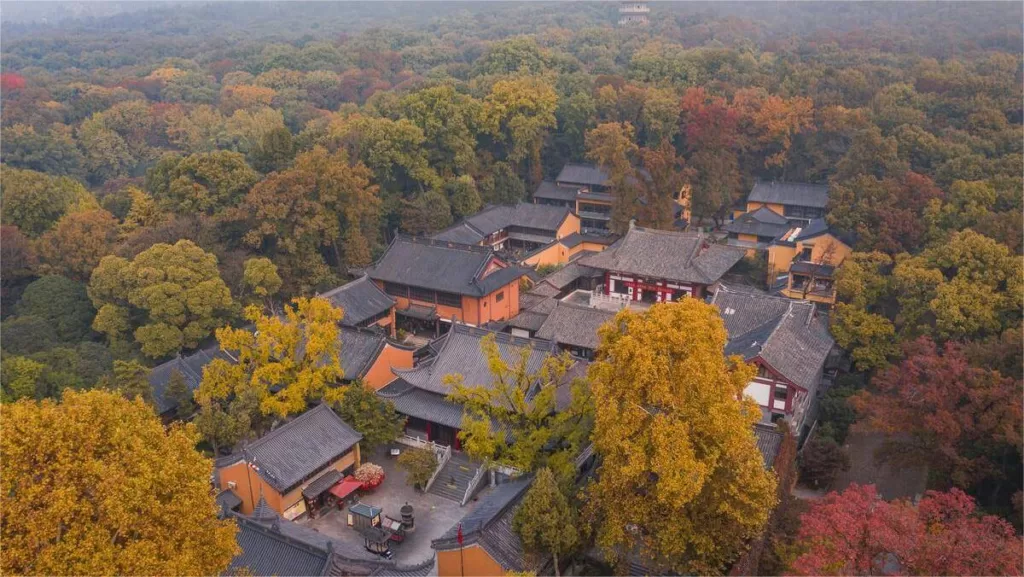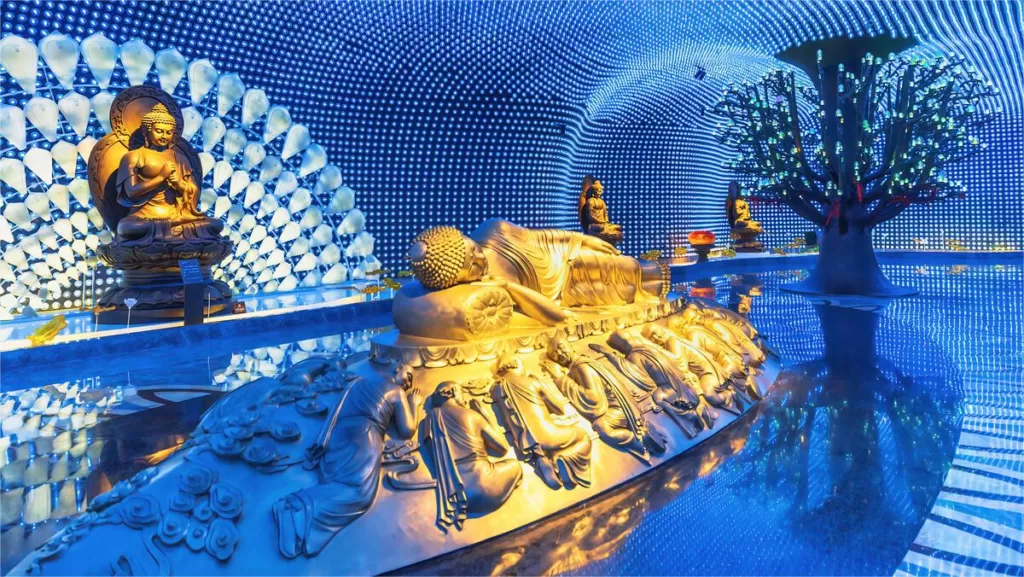Dingling Temple (定林寺), situated on Fangshan (方山) in Nanjing, boasts a history spanning over 1500 years, making it a significant site in the Southern Dynasties’ Buddhist Zen tradition. Renowned as one of the “Forty-eight Scenic Spots of Jinling” (金陵四十八景), this temple has played a pivotal role in the rich religious and cultural tapestry of city. Through the centuries, it has been a breeding ground for eminent monks and a beacon of Buddhist teachings.
In ancient times, Dingling Temple was divided into “Upper Dingling Temple” and “Lower Dingling Temple,” with the latter located on Fangshan. During the reign of Emperor Wu of the Southern Liang Dynasty, the venerable Bodhidharma, also known as Damo, from India, stayed in the capital Jiankang (present-day Nanjing). It is said that Damo conducted Buddhist activities at Lower Dingling Temple. Fangshan still preserves historical relics such as the “Damo Cliff,” marking the spot where the founder of the Zen school, Damo, is believed to have practiced meditation.
Table of Contents
- Basic Information
- Location and Transportation
- Highlights of Dingling Temple
- Vlog about Dingling Temple
- Useful Tips summarized from reviews
- Other Temples in Nanjing
Basic Information
| Estimated Length of Tour | 1 – 2 hours |
| Ticket Price | 40 RMB |
| Opening Hours | 6.00 – 18.00 |
| Telephone Number | 0086-025-52716069 |
Location and Transportation
Dinglin Temple is nestled in the southeastern suburbs of Nanjing, Jiangsu Province, approximately 20 kilometers away from the city center. The temple is surrounded by picturesque scenery, with rolling hills, lush green forests, and peaceful streams contributing to its serene atmosphere.
The nearest metro line to the Dinglin Temple is Tianyin Avenue (天印大道) on line 1. After getting out of the station from Exit 2, transfer to bus 812 or a taxi to cover the remaining 5 kilometers.
Highlights of Dingling Temple
Resilience and Enduring Spirit

Despite facing destruction and reconstruction several times throughout history, Dingling Temple endured its tribulations. In the Yuan and Ming dynasties, it underwent major renovations, only to suffer destruction again. The temple was razed to the ground during the Taiping Rebellion. In the late Qing Dynasty, a monk known as “Daoming Shizu” led efforts to rebuild and expand the temple, restoring its grandeur. However, during the Cultural Revolution, Dingling Temple fell victim to looting and destruction, leaving only the pagoda standing. It wasn’t until the era of reform and opening up that Dingling Temple experienced another revival, showcasing the resilience and enduring spirit of this ancient site.
Buddhist Cultural Artifacts

Historical records recount that after the Nirvana of Buddha, two of his sacred relics, or tooth relics, remained in the world – one went to Sri Lanka, and the other to the Wu Chong Kingdom, eventually reaching the Yuezhi people. In the 5th century, the eminent monk Faxian journeyed to Yuezhi, bringing the tooth relic to the capital Jiankang. This sacred relic found its home in the Tooth Relic Pagoda at Lower Dingling Temple, drawing devout Buddhists from all directions. Today, this tooth relic is enshrined in the Lingguang Temple on the western hills of Beijing’s Fragrant Hills.
Leaning Pagoda

The construction of Dingling Temple’s pagoda dates back to 1173, standing approximately 14.50 meters tall. It is a seven-tier, octagonal brick structure with a design mimicking wooden architecture. The lower and second levels are square, while the upper levels take on a cylindrical shape. A wooden frame supports the spire starting from the fifth level. Although the base has a single south-facing entrance, the subsequent levels have doors on all four sides. Unfortunately, due to years of neglect, the eaves, pagoda top, and spire have been damaged. The pagoda leans northward at an angle of 7.59 degrees, corrected to 5.3 degrees after restoration, surpassing the famous Leaning Tower of Pisa.
Vlog about Dingling Temple
Useful Tips summarized from reviews
Parking Information: If you have prior authorization, you can drive up to the halfway point at the parking lot. However, for other vehicles, they need to park at the entrance parking lot at the foot of the mountain.
Entrance Recommendation: To reach Dinglin Temple, it’s highly recommended to enter from the North Gate of Fangshan Forest Park. Entering from the East Gate would require a much longer walk.
Vegetarian Meals at the Temple: Dinglin Temple provides affordable vegetarian meals. The reviews mention that noodles and steamed buns are reasonably priced, but the vegetable dishes may be a bit expensive.
Topography and Geological Features: Fangshan is one of the dormant volcanoes in Nanjing. The geological formations in the area are characterized by the square-shaped rock formations due to volcanic eruptions, giving the mountain its name, Fangshan (Square Mountain).






Fangshan Park (方山公园) halfway up the mountain, there is Dinglin Temple (定林寺) where you can overlook the entire city of Nanjing. The scenery is pleasant, the air is fresh, perfect for cleansing both body and soul. Having a bowl of vegetarian noodles here is truly relaxing.